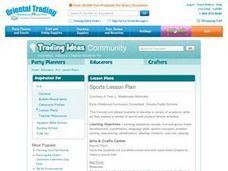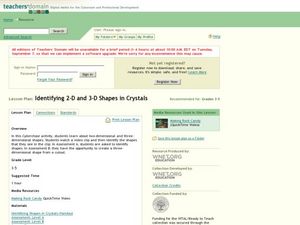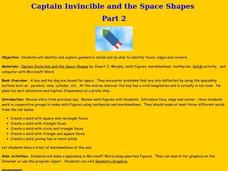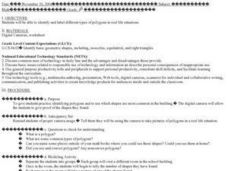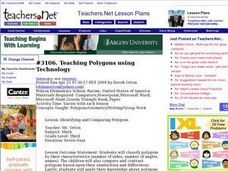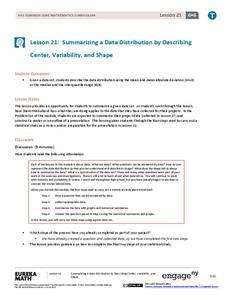Curated OER
Connecting With Coordinates
Play a coordinates game to encourage collaborative learning and grid use! Learners plot points on grids and play a game that challenges them to locate a specific point on a coordinate grid by using horizontal and vertical movements.
Curated OER
A Cone and Its Net
Create and investigate nets for solid shapes with your class. They identify the different parts and faces of each polygon and solid then calculate the surface area and volume of cones. They use circle sectors of varying sizes to build...
Curated OER
Countdown Challenge: Platonic Solids - Part I
Use a Platonic solids worksheet to record the number of faces, edges, and vertices of five polyhedra whose faces, edges, and vertices are all identical. For each figure, learners write a proof of Euler's formula (F+V=E+2). They create a...
Curated OER
Sports Lesson Plan
Have your class participate in a variety of sports and craft activities using this resource. With sports as the theme, learners work on art projects. Students create soccer ball prints, a three dimensional football, and a sports collage.
Curated OER
Identifying 2-D and 3-D Shapes in Crystals
Students view a video on making rock candy and identify the shapes they see while watching. For this 2 and 3 dimensional shape lesson, students recognize shapes and complete worksheets to identify them. Students build a cube....
Curated OER
Color in 3-D: A Nature Design Project
Students view a film about Hans Hofman and consider his use of color and layering. They experiment with the concept of 'push and pull' by using warm and cool color schemes in a tracing of leaves and shapes. Students view their work using...
Curated OER
Tessellmaniacs
Seventh graders create 3 original tessellation using polygons. They slide, turn, rotate and glide their designs on the computer. They print their tessellation on a T-shirt and teach the 6th graders about tessellations.
Curated OER
Captain Invincible and the Space Shapes
Young scholars recognize the features of geometric shapes. In this geometric shapes lesson plan, students listen to Captain Invincible and the Space Shapes. Young scholars create solid figures with marshmallows and...
Curated OER
Polygons in Real Life
Fourth graders identify and label different types of polygons in real life situations. Using a digital camera, they take pictures of polygons on the school grounds, tally the number of shapes found, and answer discussion questions.
Curated OER
Exploring Area and Perimeter
Two students are blindfolded and each receives a cardboard square, one with pompoms glued around the edge and one with pompoms glued all over the surface. They identify what they feel. The class discusses perimeter and area of polygons....
Curated OER
Polygon Perimeters
Fourth graders practice finding the perimeter of shapes. In this measurement lesson, 4th graders review the meaning of perimeter and work in groups to draw polygons with differing perimeters. Students share their polygons...
Curated OER
Teaching Polygons using Technology
Third graders utilize different types of computer programs, such as Microsoft paint and Microsoft Word to study and create different types of polygons. They use PowerPoint to create a story about a shape and others that it meets during a...
Curated OER
Similarity
Students find the factor of proportionality in similar polygons. In this similarity of polygons lesson plan, students measure the sides and angles of polygons and derive a factor of proportionality between corresponding pairs of sides...
Curated OER
Corners and Sides
In this corners and sides worksheet, learners, with a partner, explore and calculate the answers to six word problems that involve a variety of different geometric shapes.
Mathematics Vision Project
Module 5: Modeling with Geometry
Solids come in many shapes and sizes. Using geometry, scholars create two-dimensional cross-sections of various three-dimensional objects. They develop the lesson further by finding the volume of solids. The module then shifts...
Curated OER
Coordinates
For beginning point plotters, these graphs give a good introduction. They examine a graph with shapes drawn onto it and each vertex labeled. There are 20 total, and scholars write the coordinates of each labeled point. All of these are...
Curated OER
Shapes and Angles
Are your geometry whizzes learning about angles and shapes? This online worksheet gives 10 multiple choice questions based on images and word problems. Concepts include deducting angle degree, classifying shapes, and identifying angle...
Curated OER
Les Formes
What shape is a can of soda? What about a book? Develop basic shape vocabulary with your beginning French speakers. They learn nine shapes, adjectives that correlate to shapes (like if something is cylindrical, it's cylindrique), and...
Curated OER
To Be a Triangle Or Not To Be a Triangle?
In this triangles activity, 10th graders solve and complete 10 different problems that include applying the Triangle Inequality Theorem. First, they use the illustrated triangles and the data table to test the theorem. Then, students use...
Technical Sketching
Introduction — Surfaces and Edges
How different can 3-D and 2-D really be? An engineering resource provides an explanation about the importance of two-dimensional technical drawings. Several samples show how to create multi-view drawings from pictorials and...
Curated OER
Surface Area and Volume Warm-up
Learners draw the given shapes to be bigger than they are and find the surface area and volume of each shape. They complete this for two shapes.
Curated OER
Topology - The Mathematics of Distortion
In this topology worksheet, 7th graders solve and complete 12 different problems that include shapes and math distortion. First, they use the forms of capital letters as guides, stretch or bend the shape in the first column into as many...
Inside Mathematics
Two Solutions
Many problems in life have more than one possible solution, and the same is true for advanced mathematics. Scholars solve seven problems that all have at least two solutions. Then three higher-level thinking questions challenge them to...
EngageNY
Summarizing a Data Distribution by Describing Center, Variability, and Shape
Put those numbers to work by completing a statistical study! Pupils finish the last two steps in a statistical study by summarizing data with displays and numerical summaries. Individuals use the summaries to answer the statistical...



